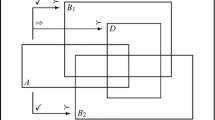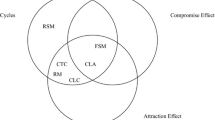Abstract
We study the behavior of a decision maker who prefers alternative x to alternative y in menu A if the utility of x exceeds that of y by at least a threshold associated with y and A. Hence the decision maker’s preferences are given by menu-dependent interval orders. In every menu, her choice set comprises of undominated alternatives according to this preference. We axiomatize this broad model when thresholds are monotone, i.e., at least as large in larger menus. We also obtain novel characterizations in two special cases that have appeared in the literature: the maximization of a fixed interval order where the thresholds depend on the alternative and not on the menu, and the maximization of monotone semiorders where the thresholds are independent of the alternatives but monotonic in menus.
Similar content being viewed by others
Notes
This version of the weak axiom of revealed preference appears in Arrow (1959).
To the best of our knowledge, the concept of anchors is new. Dominant alternatives are related to occasionally optimal alternatives, a concept which appears in Frick (2015). In particular, every occasionally optimal alternative is dominant, but not vice versa. In Sect. 4.2, we will show that occasionally optimal alternatives are precisely those anchor alternatives which are also dominant.
Equivalently P is an interval order if it satisfies asymmetry (if xPy then not yPx) and the following intervality condition: if wPx and yPz, then wPz or yPx. See Fishburn (1970).
This condition also appears as the Bliss Point axiom in Masatlıoğlu and Nakajima (2013).
See, for instance, Plott (1973) who shows that Path Independence and \(\gamma \) together characterize the maximization of strict partial orders.
References
Aleskerov F, Bouyssou D, Monjardet B (2007) Utility maximization, choice and preference, 2nd edn. Springer, Berlin
Arrow K (1959) Rational choice functions and orderings. Economica 26:121–127
Chernev A, Böckenholt U, Goodman J (2015) Choice overload: a conceptual review and meta analysis. J Consum Psychol 25(2):333–358
Chernoff H (1954) Rational selection of decision functions. Econometrica 22:422–443
Echenique F, Saito K(2015) General Luce Model, CalTech SS Working Paper 1407
Fishburn P (1970) Utility theory for decision making. Wiley, New York
Fishburn P (1975) Semiorders and choice functions. Econometrica 43:475–477
Frick M (2015) Monotone threshold representations. Theor Econ (forthcoming)
Gerasimou G (2015) Indecisiveness, undesirability and overload revealed through rational choice deferral. MPRA Working Paper 67290
Iyengar S, Lepper MR (2002) When choice is demotivating: can one desire too much of a good thing? J Personal Soc Psychol 79(6):995–1006
Manzini P, Mariotti M (2012) Choice by lexicographic semiorders. Theor Econ 7:1–23
Masatlıoğlu Y, Nakajima D (2013) Choice by iterative search. Theor Econ 8:701–728
Masatlıoğlu Y, Nakajima D, Özbay E (2012) Revealed attention. Am Econ Rev 102(5):2183–2205
Moulin H (1985) Choice functions over a finite set: a summary. Soc Choice Welf 2:147–160
Payró F, Ülkü L (2015) Similarity-based mistakes in choice. J Math Econ 61:152–156
Plott C (1973) Path independence, rationality and social choice. Econometrica 41:1075–1091
Schwartz T (1976) Choice functions, revealed preference. J Econ Theory 13:414–427
Sen A (1971) Choice functions and revealed preference. Rev Econ Stud 38:307–317
Szpilrajn E (1930) Sur l’extension de l’ordre partiel. Fundam Math 16:386–389
Tyson C (2008) Cognitive constraints, and the satisficing criterion. J Econ Theory 138:51–70
Author information
Authors and Affiliations
Corresponding author
Additional information
We acknowledge helpful comments by Sean Horan, Romans Pancs and two referees. The first author was partially supported by FWF grants P-26076-N25 and I-1897-N25. The second author gratefully acknowledges financial support from Associación Mexicana de Cultura.
Rights and permissions
About this article
Cite this article
Aguilera, J.P., Ülkü, L. On the maximization of menu-dependent interval orders. Soc Choice Welf 48, 357–366 (2017). https://doi.org/10.1007/s00355-016-1007-7
Received:
Accepted:
Published:
Issue Date:
DOI: https://doi.org/10.1007/s00355-016-1007-7




